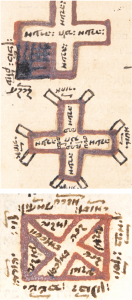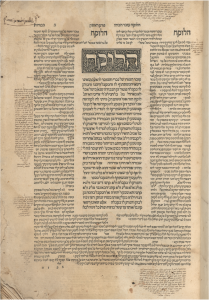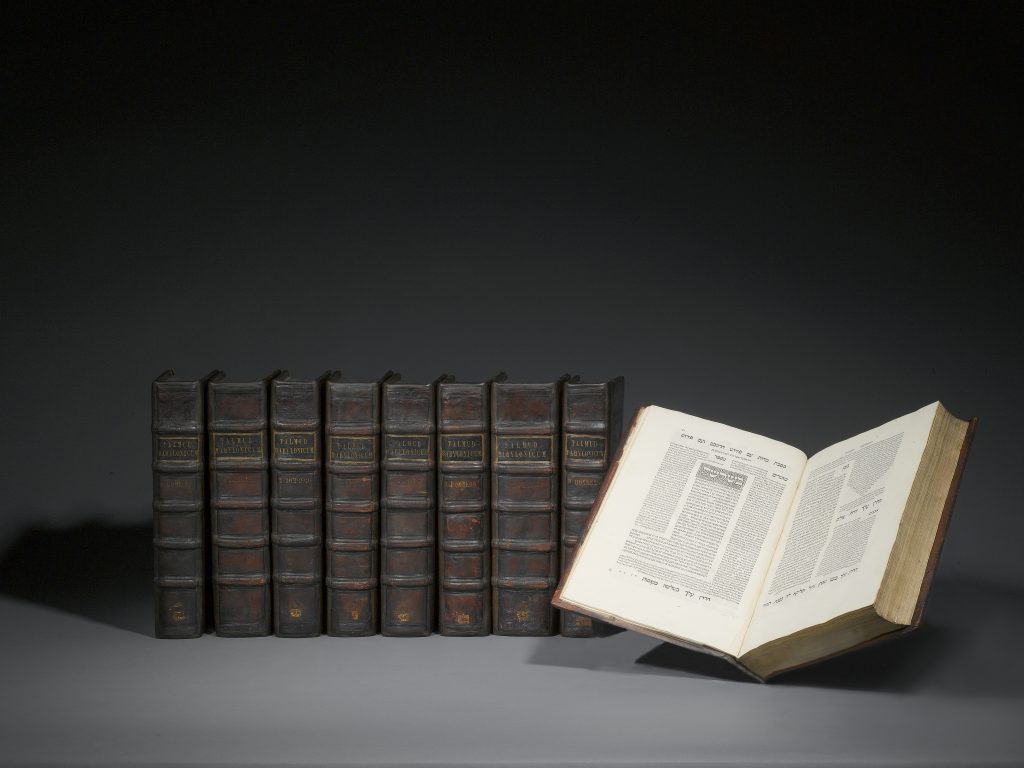Printing the Shas
Commemorating the 500th anniversary of the printing of the Bomberg Talmud, Columbia University librarian Michelle Chesner tells the story of the monumental printing of the Bomberg Talmud, the first complete set of Shas to ever be printed.
In December of 2015, as part of my many duties as the librarian for Jewish studies at Columbia University, I attended an auction at Sotheby’s in New York. The sale included unique and precious items from the famed Valmadonna Trust Library, a collection that included Jack Lunzer’s complete set of the so-called Bomberg Talmud. There was plenty of animated bidding on the lot, and the set finally sold for nearly $10 million, breaking records for the highest price ever paid for a set of Jewish books.
The Bomberg Talmud contained a combination of the first and second complete editions of the Talmud, using the relatively new technology of moveable type. Printed in Venice by a Christian, this set was a rare complete copy of the volumes that set the standards for printed Talmudim still in place today. Daniel Bomberg started his monumental task of printing Shas 500 years ago, in the Hebrew year 5280, which began in the year 1519 of the modern era.
Even in an era when everyone has easy access to a computer and a printer, the magnitude of printing the Talmud is easy to understand. Creating the very first complete printed edition on a fully manual hand press was a monumental feat. The text of each of the nearly 3,500 leaves had to be laid out by hand, with each line of type carefully measured and set into place. The unique format of the Talmud, with Rashi and Tosafot on either side of the Talmud text, meant that pages needed to be designed in advance to ensure an even distribution of the text.
Earlier Talmud Printings
The Bomberg Talmud was the first complete set of Shas to be printed, but it wasn’t the first printing of Gemara. Individual masechtot were produced during the fifteenth century in both the Iberian and Italian peninsulas. At least nine volumes1 were printed in Guadalajara, Spain, around 1480, with only Rashi’s commentary, a scant decade after the beginning of Hebrew printing. Jewish printers in Spain would be expelled a dozen years later (along with the rest of the Jews), though, and so a set of Shas was not completed on the Iberian Peninsula.
Bomberg had significant funds at his disposal, and thus could afford the investment required for this huge project. The cost of paper alone would have been astronomical.
There was a bit more freedom for Jews in Italy during the same time period. On December 19, 1483, Gershom Soncino printed his first volume of Talmud: Masechet Berachot with Rashi and Tosafot. This is the earliest dated volume of Talmud that we have today. Soncino determined the modern layout of the Talmud page, with Rashi on the inner margin and Tosafot on the outer, as well as the standard layout of four lines of commentary before the Talmud text. Soncino and his heirs attempted to print a complete set over the next four decades,2 but Daniel Bomberg’s work effectively took over the market.
The Talmud was not Bomberg’s first foray into Hebrew printing. In 1515, Bomberg applied to the authorities for a privilege to print Hebrew books in Venice.3 That same year, he produced a Latin Psalter with some Hebrew type, and his Biblia Rabbinica of 1517 (with nikud, commentary and cantillation marks) is possibly one of the most beautiful examples of early Hebrew printing from the period. By 1518, Bomberg had received the “exclusive right to print Hebrew books for ten years” in Venice, thus setting his grand plans into motion.4
Printing the Whole Shas
Before beginning the work, Bomberg sought manuscripts from around the world to ensure that his copy was as accurate as possible.5 Not only was the text of the Talmud and its main commentaries important, but he also added additional commentaries following the main text: the Piske Tosafot, Rambam on the Mishnah and the Rosh (Asher ben Yechiel).
Bomberg had significant funds at his disposal, and thus could afford the investment required for this huge project. The cost of paper alone would have been astronomical. But Bomberg had bigger plans. He hired expert editors and typesetters, and even requested a special privilege allowing his Jewish employees permission to walk through Venice without the yellow berets identifying them as Jews so they would not be accosted on their way to or from work.6
One of Bomberg’s most important innovations in his printing of the Talmud was the concept of fixing the text on each page. The whole reason that a Daf Yomi cycle can be completed is because everyone, anywhere in the world, using any edition, can be studying the same page with the same text. Daniel Bomberg was also the first to add foliation (numbering leaves, or dapim) to the Talmud, and the vast majority of printers followed his layout of the text.
The reason that the Talmud text begins on 2a rather than 1a can be traced to Bomberg—or simply understood as a relic from the early print era. During the 15th and 16th centuries, printers would sell texts printed on stacks of paper, which the new owner then brought to a binder to make the book “shelf ready.” The binding only took place after the book left the printshop. Printers numbered the pages to make the binder’s work easier, thereby ensuring that the text was in order (especially for non-Roman texts, such as Hebrew, which the binders most likely could not read). Thus the title page was not usually numbered because the binder recognized it as page 1, and the numeration began with page 2, as we see with the Talmud today.
Even the concept of daf and amud is a carryover from early print. Printers numbered folios (a single sheet of paper, or a daf in Gemara) rather than pages (each side of the page, or an amud) because they were guides to the binders, similar to the above. Because later printers were so careful to stay true to Bomberg’s printing style, this remained well after pagination was introduced in printed books.

Hand-drawn diagrams of possible catacombs (relevant to a discussion in Bava Batra 101a about tumah and taharah) in a volume of Bomberg’s Bava Batra in the Lowy Collection at the Library and Archives Canada, call number: BM506 B4 1521 x.fol. Photo: Tom Thompson
Although moveable type made book production orders of magnitude easier than writing books by hand, printing illustrations was still a difficult and time-consuming process in the sixteenth century. The Talmud isn’t known for its many illustrations, but there are actually quite a large number of diagrams referenced in the main Talmud text as well as in the commentaries. Daniel Bomberg dealt with them the easy way—he left a blank square or rectangle next to text where an image was referenced. Perhaps he meant to have them filled in later, as with many early printed non-Jewish texts that left blank spaces for capital letters meant to be illuminated by hand. In most Bomberg editions, however, these spaces remain blank to this day. There are some notable exceptions, though, such as the one from the Jacob M. Lowy collection at the Library and Archives Canada [see illustrations on page 50].
Nearly every printer of the Talmud in the centuries that followed—until the modern era—followed the standards set by Bomberg in their printing of the Shas.
Later Additions
In looking at existing copies of the Bomberg Talmud today, one can see why later amendments were made to the Talmud page. Annotated copies, like an edition of Masechet Shabbat printed in 1522 now at Columbia University,7 show what is essentially the Masoret haShas, the citations to the references made in the text, added along the margin. Following demand, printers would print those citations in later editions.

The owner of this volume of the Bomberg Talmud handwrote the entire text of Rabbi Betzalel Ashkenazi’s Shitah Mekubetzet in the margins of each tractate bound in this volume. Pictured here is a page at the beginning of Masechet Bechorot. Courtesy of Columbia University Libraries, call no. B893.1NI B20 v.16.
A particularly interesting volume at Columbia University8 contains the entire text of the Shitah Mekubetzet by Rabbi Betzalel Ashkenazi. The owner of a copy of Seder Kodashim from the Bomberg Talmud wrote the entire text by hand within the margins of the book. Other volumes, conceivably owned by the same person, exist in other collections as well and are similarly annotated.
The Talmud and the Church
From the political-religious perspective, it was no simple project to print a Talmud, regardless of whether one was Christian or Jewish. Bomberg had initially been required to include a Christian response to the Talmud within his volumes, which would have alienated potential Jewish buyers. (This was a legitimate concern—Jews would later boycott the works of a printer in Prague who had converted from Judaism to Christianity in 1539.9) With some luck and continuous advocacy, however, Bomberg was able to print the Talmud without the Christological inclusions.
The trouble with print, as the Catholic Church soon learned, was that it allowed the wide dissemination of texts that had the potential for heresy. The Talmud had long been seen as a problematic text that held the Jews back from seeing the “light” of Christianity, and once it was printed, it was referenced as banned in early editions of the Index Librorum Prohibitorum, the official Church volume of prohibited books.
On Rosh Hashanah in 1553, the Church ordered a public burning of the Talmud at Campo de’ Fiori in Rome. It was caused by a dispute between two printers of Hebrew books, and it decimated the remainder of Bomberg’s stock. In later years, the many persecutions and peregrinations of the Jews in the centuries following meant that the survival of an original complete copy of the Bomberg Talmud is incredibly rare.
Only twelve complete copies exist whose history can be traced continuously (as a set) to the 16th century. All but the copy from the library of Rabbi David Oppenheim (now at the Bodleian Library at the University of Oxford) were owned by Christians, which no doubt played a critical role in their survival.10 There are collections that contain an example of each masechet printed by Bomberg, but those have been assembled in the centuries after Bomberg’s work by purchasing individual masechtot one by one.
The Bomberg Talmud Today
There are many volumes still in existence around the world, and for many Judaica collectors, completing a Bomberg Talmud set is an ideal goal. Costs for individual tractates thus vary significantly. In fact, in a sale at the end of 2018, a copy of Keritot (of the second edition, 1528) sold for just under $7,000, while a Chullin (of the first, 1521) sold for more than ten times that at $100,000. I learned very quickly when I first entered the field of rare Judaica as a professional that the cost of any book is simply what one person is willing to pay.
As we near the completion of the thirteenth cycle of the Daf Yomi, one can only wonder—was the original printing of the Shas ever used in its entirety? Was there anyone who completed the Daf (in this cycle or otherwise) using an edition of Daniel Bomberg’s Talmud? Who were the people who pored over these newly printed volumes in Italy (and beyond) 500 years ago? Regardless of which imprint one prefers today, every mesayem from 1519 to 2019 has been impacted by the monumental Talmud printed by Daniel Bomberg.
Notes
1. Masechtot Chullin, Yoma, Chagigah, Beitza, Berachot, Mo’ed Katan, Kedushin, Ketubot, Ta’anit and possibly others that have not survived.
2. Twelve different masechtot printed by Soncino are extant today, although more may have been printed and are now lost.
3. Piattelli, Angelo M. “New Documents Concerning Bomberg’s Printing of the Talmud,” in Mehevah le-Menahem: Studies in Honor of Menahem Hayyim Schmelzer, ed. Shmuel Glick, Evelyn M. Cohen, Angelo M. Piatelli (Jerusalem, 2019), 176. There is some discussion as to when Bomberg established his press, but there are no extant copies of works that he printed before 1515.
4. Piattelli, “New Documents,” 178.
5. Marvin Heller, “Daniel Bomberg-The Editio Princeps,” Printing the Talmud: A History of the Earliest Printed Editions of the Talmud (Brooklyn, 1992), 145. He notes that Bomberg’s errors followed Soncino errors, and some text clearly removed for censorship purposes followed the Pesaro edition. So Bomberg certainly leaned on Soncino for some of his work.
6. Piattelli, “New Documents,” 177.
7. B893.1NI B20, v.22, containing Masechet Shabbat (printed 1522).
8. B893.1NI B20, v.16, containing Masechtot Bechorot, Eruvin, Temurah (printed 1522), as well as Keritot (printed 1525). The same volume contains Mesechtot Me’ilah/Kinim/Tamid/Middot as well, but without manuscript notes.
9. See Magda Teter and Edward Fram, “Apostasy, Fraud, and the Beginnings of Hebrew Printing in Crakow,” AJS Review 30, no. 1 (2006): 47.
10. A complete listing of these copies and their provenance can be found in Sotheby’s New York sale catalog which includes the Valmadonna Talmud as Lot 12 (December 22, 2015) as well as in Milton McC. Gatch and Bruce E. Nielsen, “The Wittenberg Copy of the Bomberg Talmud,” Gutenberg Jahrbuch 78 (2003): 296-326.
Michelle Chesner is the Norman E. Alexander librarian for Jewish studies at Columbia University; co-director of Footprints: Jewish Books Through Time and Place; and president of the Research, Archives, and Special Collections Division of the Association for Jewish Libraries. She lives in New Jersey with her family.
Special thanks to Michael Kent, senior librarian, Published Heritage Branch, Library and Archives Canada, for his assistance in obtaining images for this article.
More in this Cover Story:
Up Close with Dr. Henry Abramson, interview by Sholom Licht

